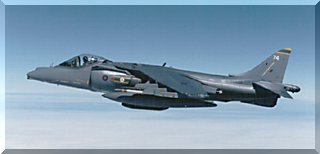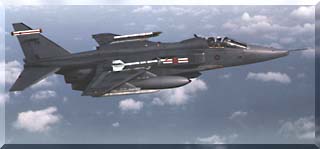| Unoffical RAF Website
Offensive Aircraft
Defensive Aircraft
Reconnaissance and Maritime Patrol Aircraft
Tanker Aircraft
Joint Strike Fighter
Eurofighter
Guest Book
Favorite Links Page
Catalog Page
|
|
Here are the Attack and Strike Aircraft of the RAF
|
 Harrier GR7
Powerplant: One Rolls-Royce Pegasus Mk 105 vectored thrust turbofan of 21,750lb st (86.7kN)
Harrier GR7
Powerplant: One Rolls-Royce Pegasus Mk 105 vectored thrust turbofan of 21,750lb st (86.7kN)
Span: 30ft 4in (9.24m)
Length: 46ft 4in (14.12m)
Max Speed: 661mph (1,065km/h)
Armament: Two 25mm cannon on under-fuselage stations. Up to sixteen Mk 82 or six Mk 83 bombs, six BL-755 cluster bombs, four Maverick ASMs, or 10 rocket pods on seven wing stations.
|
|
The Harrier GR7 is the Latest in a long line of Harrier jump jets that have the STOVl capability starting with the GR3 the Harrier GR7 is in essence a licence built American Harrier AV-8B Harrier II fitted with RAF-specific navigation and defensive systems as well as other changes including additional underwing pylons for Sidewinder missiles.The improved design of the GR7 allows the aircraft to carry twice the load of a GR3 over the same distance or the same load twice the distance. First flight of the Harrier GR7 was in 1989, and deliveries to RAF squadrons began in 1990. A total of 96 aircraft were ordered, including 62 interim GR5s which were later modified to GR7 standard.
|
|
Jaguar GR1B
The Jaguar was a development between French and British co-operation.in 1965 for a dual-role advanced/operational trainer and tactical support aircraft, the Jaguar has been transformed into a potent fighter-bomber. The RAF originally intended to use the aircraft purely as an advanced trainer, but this was later changed to the offensive support role on cost grounds. The first RAF aircraft took to the air in October 1969, and each air force placed orders for 200 aircraft - the RAF opting for 165 single-seat and 35 two-seat aircraft.
Tornado GR1
The mainstay of the strike/attack force is the Tornado GR1. Designed and built as a collaborative project in the UK, Germany and Italy, the Tornado programme was initiated in 1968 and known as Multi-Role Combat Aircraft (MRCA). A new tri-national company, Panavia, was set up in Germany to build the aircraft. The first prototype flew on 14 August 1974 and initial orders from the three partner countries totalled 640 aircraft, with the work share divided in relation to the number of aircraft ordered; UK and Germany 42.5% each and Italy 15%. The initial RAF requirement was for 220 aircraft.Designed from the outset as a low-level supersonic aircraft, Tornado is capable of carrying a wide range of conventional stores, including the Air-Launched Anti-Radar Missile (ALARM), Paveway II and III laser-guided bombs (LGBs). Future plans include carriage of the new Storm Shadow long-range stand-off missile and the Brimstone anti-armour missile.
|
 Jaguar Gr1B
Powerplant: Two Turbomeca/Rolls-Royce Adour 104 turbofans of 7,305lb st.
Jaguar Gr1B
Powerplant: Two Turbomeca/Rolls-Royce Adour 104 turbofans of 7,305lb st.
Span: 28ft 6 in (8.69m)
Length: 55ft 2.5in (16.83m)
Max Speed: 990mph (1,593km/h) at 36,000ft (11,000m).
Accommodation: GR1B pilot only; T2: pilot and pupil in tandem.
Armament: Two 30mm Aden guns and up to 10,000lb (4,500kg) stores including Martel, rockets and laser-guided bombs.
|
Tornado GR1
Powerplant: Two afterburning Turbo Union RB199-103 turbofans of 15,800lb st.
Span: 45ft 7.25in (13.90m) - wings fully spread; 28ft 2.5in (8.59m) - 68° sweep
Length: 54ft 9.5in (16.70m)
Max Speed: 1,452mph (2,336km/h) at 36,000ft (11,000m)
Accommodation: Pilot and navigator in tandem seating
Armament: Two IWKA-Mauser 27mm cannon (one on the GR4) and up to 18,000lb of ordnance
|
|
|
